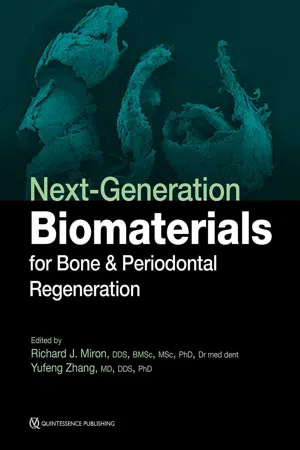
Next-Generation Biomaterials for Bone & Periodontal Regeneration
- 384 pages
- English
- ePUB (mobile friendly)
- Available on iOS & Android
Next-Generation Biomaterials for Bone & Periodontal Regeneration
About this book
New and innovative biomaterials are being discovered or created in laboratories at an unprecedented rate, but many of them remain entirely foreign to practicing clinicians. This book addresses this gap in knowledge by summarizing some of the groundbreaking research performed to date on this topic and providing case examples of these biomaterials at work. The book begins with a review of the biologic background and applications of bone grafting materials utilized in dentistry. The principles of guided tissue and bone regeneration are covered in detail, including many recent advancements in barrier membrane technologies as well as use of platelet-rich fibrin and various growth factors, and many next-generation materials that will optimize future bone and periodontal regeneration are presented. The final chapter is designed to help clinicians select appropriate biomaterials for each specific regenerative protocol. Much like one implant size and shape cannot be utilized for every indication in implant dentistry, one bone grafting material, barrier membrane, or growth factor cannot maximize regenerative outcomes in all clinical situations. This textbook teaches clinicians how to utilize biomaterials in an appropriate, predictable, and evidence-based manner. 384 pp; 960 illus; 2019
Frequently asked questions
- Essential is ideal for learners and professionals who enjoy exploring a wide range of subjects. Access the Essential Library with 800,000+ trusted titles and best-sellers across business, personal growth, and the humanities. Includes unlimited reading time and Standard Read Aloud voice.
- Complete: Perfect for advanced learners and researchers needing full, unrestricted access. Unlock 1.4M+ books across hundreds of subjects, including academic and specialized titles. The Complete Plan also includes advanced features like Premium Read Aloud and Research Assistant.
Please note we cannot support devices running on iOS 13 and Android 7 or earlier. Learn more about using the app.
Information
05
Next-Generation Natural Bovine Bone Mineral Grafting Material with Integrated Atelocollagen Type 1
Richard J. Miron / Mustafa Abd El Raouf / Yufeng Zhang / Andrea Grassi / Ferdinando D’Avenia
Summary

Biologic Background
Graft fabrication
Effect of atelocollagen incorporation into xenografts in vitro



Table of contents
- Cover
- Halftitle Page
- Copyright Page
- Title Page
- Contents
- Dedication
- Preface
- Contributors
- 01 The Regenerative Properties of Bone Grafts: A Comparison Between Autografts, Allografts, Xenografts, and Alloplasts
- 02 Autogenous Bone: The Gold Standard for Bone Regeneration
- 03 The Use of Allografts for Bone and Periodontal Regeneration
- 04 The Use of Xenografts in Implant Dentistry and Periodontology
- 05 Next-Generation Natural Bovine Bone Mineral Grafting Material with Integrated Atelocollagen Type 1
- 06 Synthetic Bone Substitute Materials
- 07 Next-Generation Osteoinductive Synthetic Calcium Phosphates: Osopia
- 08 The Use of Autogenous Dentin Particulate Graft for Alveolar Ridge Preservation and Augmentation Following Tooth Extraction
- 09 Next-Generation Osteoconductive Resorbable Bone Adhesives: Tetranite
- 10 3D Printing Scaffolds for Alveolar Bone Augmentation
- 11 Membranes for Guided Tissue and Bone Regeneration
- 12 Autogenous Blood-Derived Barrier Membranes: Platelet-Rich Fibrin in Regenerative Dentistry
- 13 Bone Regeneration with Bone Morphogenetic Protein 2
- 14 Enamel Matrix Derivative: Preclinical Biologic Background
- 15 Enamel Matrix Derivative: Clinical Studies
- 16 Efficacy of Recombinant Human PDGF and FGF-2 for Regenerative Dentistry
- 17 Combination Approaches for Periodontal Regeneration: Biologics, Bone Grafts, and Barrier Membranes
- 18 Next-Generation Bone Morphogenetic Protein 9: The Future of Bone Regeneration?
- 19 Osteogain: The Next Generation of Enamel Matrix Derivative
- 20 Next-Generation Wound Healing with Hyaluronic Acid
- 21 Next-Generation Ion Incorporation into Bone Grafts for Bone and Periodontal Regeneration
- 22 Next-Generation Use of Gene Therapy for Growth Factor Delivery
- 23 Clinical Recommendations and Guidelines for Selecting Biomaterials for Bone and Periodontal Regeneration
- Abbreviations
- Index